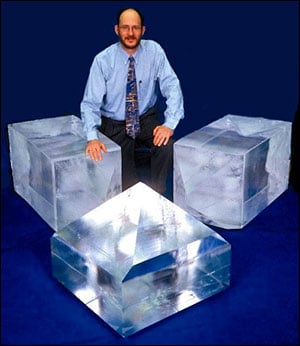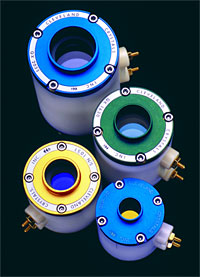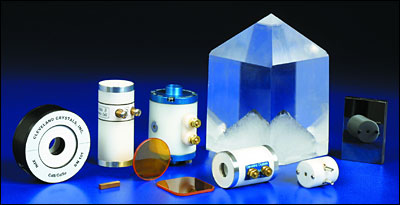
Cleveland Crystals: Small Firm with a Big Role in the Laser Industry
HIGHLAND HEIGHTS, Ohio, Aug. 28, 2007 -- Cleveland Crystals Inc. is a small company that plays a very large role in the laser industry, thanks to its unparalleled ability to grow high-quality crystals for laser, electro-optics and laser fusion applications.
Crystals are fascinating substances. Some have interesting properties relating to their interactions with electricity, sound, laser light, and heat. The ability to grow them, whether you want crystals the size of a pencil eraser (such as those used for intracavity harmonic generation) or require ones that weigh as much as 1500 pounds (used to supply optics for inertial confinement fusion applications), is an art that requires well-developed skills in physical chemistry. The work is complemented by a team of physicists, engineers and technicians, who help create finished optical components and assemblies.
Cleveland Crystals President Jeff Luken with some of the large KDP boules grown by the company for use in laser fusion applications.
That is especially true at Cleveland Crystals, where the largest KDP (potassium dihydrogen phosphate) boules, or ingots, in the world are grown. In fact, Cleveland Crystals has no equal in the crystal growth of these large KDP boules.
"Such crystals are grown by two techniques. One is quicker but grows them smaller, the other takes significantly longer but makes them quite large and with a reduced level of defects," said Cleveland Crystals Vice President of Technology Gary Catella.
In general, crystals, grown either by high-temperature methods or in an aqueous solution, can be very rugged or soft and easily scratched, depending on the material they are grown from, and every crystal is unique. The majority of those grown by Cleveland Crystals are for customers such as major laser OEMs, leading universities and government laboratories.
For high-temperature crystal growth, the company uses techniques including Bridgman, physical vapor transport, and the Czochralski family of methods. (More on these techniques later).
Cleveland Crystals was also the first -- and remains a large -- commercial producer of BBO (beta barium borate) in the US. BBO is a crystal used for both nonlinear and electro-optics applications.
A Sound Foundation
For a small company like Cleveland Crystals to become such a big player in the industry, it required a solid foundation built by exceptionally talented and creative people.
In the 1930s, decades before the formation of Cleveland Crystals, Dr. Hans Jaffe, a German scientist working in the US, was focused on developing crystals for sonar applications. He and his staff at the Brush Development Co. (eventually combined first with Cleveland Graphite Bronze to form Clevite Corp., which in turn was acquired by Gould Inc.) became authorities in the field, writing the first basic papers about piezoelectric crystals, providing the foundation for sonar crystal development for military and civilian applications.
The scientists continued their crystal growth work through the 1950s, and when the laser was developed in the 1960s it was discovered that the properties of crystals that allow them to interact with electricity, heat and/or sound made them ideal for laser experiments. The company soon began working with laser scientists on experiments showing how laser light interacts with crystals.
Cleveland Crystals' QX series Pockels cells ( electro-optic Q-switches)
By the early 1970s, crystals had found use as Q-switches (a practical application of electro-optics). They could be used to build high-speed optical switches, and used as optical frequency doublers, triplers, quadruplers, etc. But the parent company, Gould, wasn't interested in pursuing these applications for crystals, so the scientists who had worked with them for the previous 20 years decided to take a risk, buy out that part of the company and form their own, leading to the creation of Cleveland Crystals in 1973.
The emerging company's focus was directed to the development of nonlinear-optical crystalline materials, optical frequency conversion, and precision-engineered electro-optical devices for applications in the growing laser industry.
Cleveland Crystals began to provide crystals to laser researchers and to the military for defense applications. By the mid-70s, production at the company was in full swing, as its growing list of products included electro-optical devices, harmonic generators and other nonlinear frequency conversion crystals, and infrared (IR) wave plates, among others.
By the 1970s, scientists at the national labs and one private research corporation began using lasers for fusion experiments, and realized they would need really large, high-quality crystals to produce the high number of large laser beams required for their work.
The original founders of Cleveland Crystals have all passed away now, including Lee Shiozawa in March 2006. When the company was founded in 1973, Shiozawa served as vice president/principal scientist, then president from 1979 to 1997 before becoming chairman and chief scientist.
It was Shiozawa who guided the company’s development of KDP and KD*P (KDP with heavy hydrogen added) crystals, dedicating his professional life to understanding crystalline growth and the interaction of crystals with light, electric fields and sound.
"As a scientist, Lee had key roles in the expanding fields of synthetic crystal growth and laser optics, providing enabling technologies for diverse applications, including tabletop lasers, giant inertial confinement fusion lasers, medical systems and infrared countermeasures," Catella said. "Lee was the genius who kept this place going."
The company is now in the capable hands of Jeffrey R. Luken, who has been Cleveland Crystals president since 2000. Prior to becoming head of the company, Luken was already a 23-year veteran of Cleveland Crystals, having served as executive vice president, manager of ICF products, general manager and production manager.
Cleveland Crystals now employs approximately 58 at its facilities on Alpha Drive in Highland Heights and on Redwood Avenue in Cleveland (where the high-temp. crystals are grown). It is a talented, dedicated and well-educated group, with most having worked there for 10 years or more.
"Most people have been here for a long time -- there is little turnover. It's a good place to work," Catella said. Fully half of the staff is degreed, he said.
The company was sold in 1999 to the Gooch & Housego Group, a manufacturer of high quality precision optical components, glass engineered structures, acousto-optics, radio frequency drivers and related devices.
Crystals for Fusion
"The University of Rochester's Laboratory for Laser Energetics (LLE), Lawrence Livermore National Lab (LLNL), the Naval Research Lab (NRL) -- we started working with them very early to grow large, high-quality crystals," Catella said. "If you have a 14-inch by 14-inch beam, you need a big crystal out of which to cut optical components."
The crystals grown for laser fusion experiments are typically KDP or KD*P (the deuterated form). KDP is a transparent dielectric material best known for its nonlinear optical and electro-optical properties. Because of its nonlinear optical properties, it has been incorporated into various laser systems for harmonic generation and optoelectrical switching. In addition, KDP is particularly suitable for use in large-aperture laser systems such as that located at the National Ignition Facility (NIF), because it can be grown as a single crystal to a large size.
Because of the size of the beams needed for these experiments -- at the NIF, each beam is 40 cm on a side, and there are 192 beam lines -- there was great demand for really large, high-quality crystals, Catella said, like those only Cleveland Crystals could provide.
Cleveland Crystals has become the world leader in the growth and fabrication of large-aperture KDP and KD*P crystals for inertial confinement fusion (ICF) applications. The company has partnered with LLNL to optimize the rapid crystal growth method to produce large crystals for various parts of LLNL’s ICF program.
Crystal Growth
The Bridgman crystal growth technique is a method of growing single crystal ingots or boules at elevated temperatures. It involves heating polycrystalline material in a sealed container above its melting point and slowly cooling it from one end, where a seed crystal is located. Single crystal material is progressively formed along the length of the container, and the process can be carried out horizontally or vertically. It is a popular method of producing certain semiconductor crystals, such as gallium arsenide or cadmium telluride, where the Czochralski process is more difficult.
The Czochralski (CZ) process produces the majority of commercially available single crystals by yielding fairly large crystals with low defect concentrations. It is especially suited to semiconductor (e.g. silicon) and oxide (Nd: YAG and titanium:sapphire) crystal growth.
A modified form of the CZ process, top-seeded solution growth, is used, in Cleveland Crystals' case, to obtain single crystals of high-temperature crystals, such as BBO. Generally speaking, the Bridgman and CZ families of growth methods are suitable for relatively small crystals. (Scintillation crystals for radiation detection would be an exception.)
Addressing the need for large crystals usually requires low temperature solution growth techniques. The really large potassium diphosphate crystals can be 1.4 meters tall and weigh three-quarters of a metric ton. Water soluable, they are grown singly in large tanks of an aqueous solution and can take almost two years to reach full size.
"The really large stuff is usually grown to order," Catella said. "You have to work with people who understand time constraints and have long event horizons. You also have to anticipate demand many months or years in advance."
Spending years to grow a crystal only to have a problem in the final stages is not something the staff likes to think about, or, thankfully, is a problem they have to deal with very often.
Supporting Technologies
Cleveland Crystals has developed proprietary software that gives it the unique ability to supply optimized crystals for many applications, including those with high average power.
A collection of some of the products manufactured by Cleveland Crystals.
The company's optical coating capabilities, developed to keep all its crystal-related services in-house, cover the UV-IR range and include custom thin-film design and deposition capabilities for dielectric, sol-gel, and hybrid coatings.
Cleveland Crystals' SolGel Group has the ability to coat large-aperture astronomical optics, having successfully coated, for example, spectrographic lenses for the Smithsonian Astrophysical Observatory.
Also, the company's manufacturing capabilities are supported by a unique competency in optical fabrication and an in-house precision machine shop.
Because most crystals require antireflective coatings and many crystals require special care and handling, Cleveland Crystals decided it should keep those jobs inside the company, and it has subsequently developed coating capabilities and techniques that are specifically enhanced for use with the various crystals.
"Being vertically integrated gives us excellent quality control," Catella said.
For nearly 30 years, Cleveland Crystals has also produced the world's best and largest cadmium sulfide (CdS) and cadmium selenide (CdSe) wave plates for the IR spectrum.
Wave plates, also known as retardation plates, allow the polarization of the incident beam to be altered. Upon entering the crystal, the beam is propagated as two different and independent polarization modes. When the beam emerges, after passing through a wave plate, these modes recombine to form a single beam with an altered polarization.
The company's IR achromatic wave plates, used for manipulating the polarization state of light over broad bands of wavelengths (in some cases over a full octave wavelength range), have a variety of applications in astronomy, spectrophotometry, remote sensing, etc. They are a unique capability of Cleveland Crystals, he said.
"IR achromats are a specialty we have made our own since the mid-90s," he said. "It started out from a university person with an idea that we turned into reality, and then turned into a business. The design and fabrication of achromatic waveplates for the IR is difficult to do well."
Another major product area for Cleveland Crystals is electro-optic devices, such as Pockels cells, primarily for laser Q-switches and modulators. When a Pockels cell is used in a laser cavity, it is often referred to as an electro-optic (E-O) Q-switch. As such, E-O Q-switches are used to shorten the output pulse, resulting in a light beam with enhanced peak intensity.
In a related application, Pockels cells are used as laser beam "switch-in/switch-out" components in regenerative amplifiers. In both applications, the short switching times (on the order of nanoseconds, made possible by the properties of the crystal), allow the desired function of the laser.
The Future's Not Crystal Clear
Although it is one of the top crystal growers in the world, even Cleveland Crystals can't grow itself a crystal ball to see its future. While the company faces tough competition from China and Eastern Europe, the fact that Cleveland Crystals makes the largest crystal boules available, as well as other unique products, allows it to stay ahead of the competition.
The company works hard to provide its customers with quality service and support. And Catella said working with customers is one of the best parts of his job.
"It's the customers who find new uses for our crystals. One of the best parts of my job is interacting with the user community out there. Crystals, optics, and lasers, it's not that big a community, it's mostly researchers, students, and government labs. Some of the best parts of what we do is interacting with them and finding whole new ways of applying these things.
"It's still an industry where people are learning new stuff all the time," he said. "Any given crystal family has its quirks. I've been here 21 years and I'm still learning."
For more information, visit: www.clevelandcrystals.com
Cleveland Crystals Inc.
676 Alpha Dr.
Highland Heights, OH 44143
Phone: (216) 486-6100
Fax: (440) 461-1538
/Buyers_Guide/Gooch_Housego_Ohio_LLC/c2645